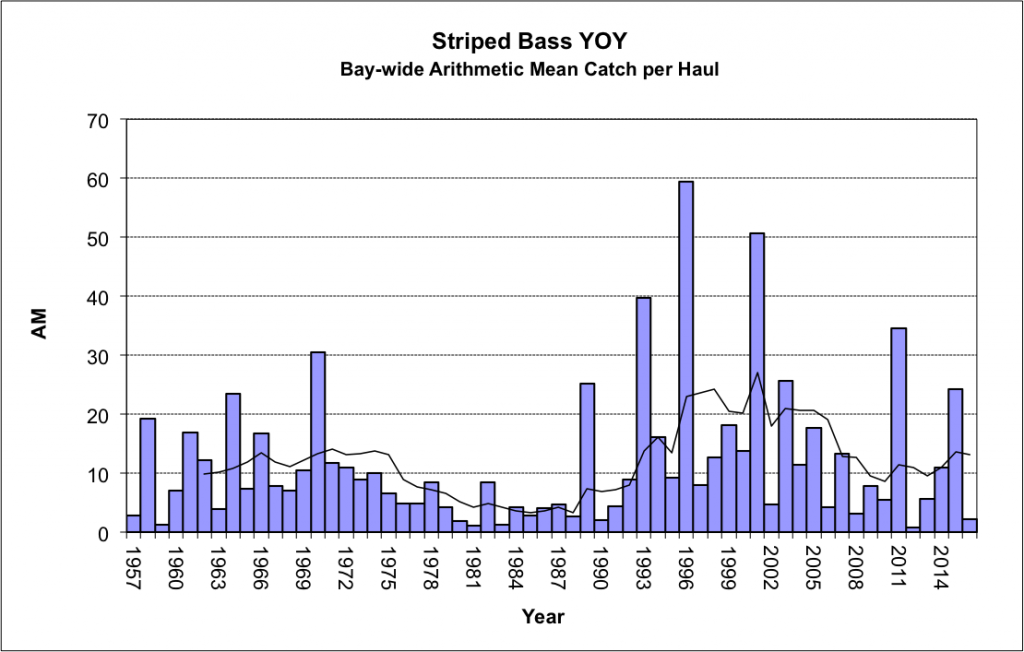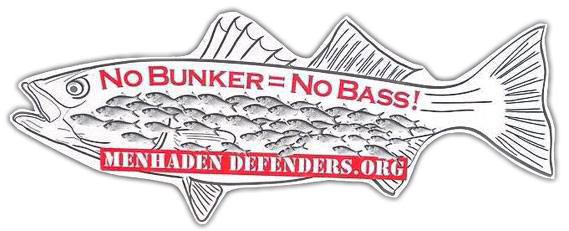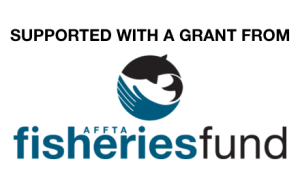2016 Annual Angler Survey Results
The results of the Stripers Forever 2016 Annual Fishing Survey are finalized, supporting documents are below this commentary. In 2016 we received 684 responses to our annual survey. This was an increase of 27 from last year. This year’s survey has again produced a good representative sampling of sentiments from fishers all along the striper’s migratory range, and as usual MA and NJ vied for the greatest contributions with 174 and 149 completed surveys respectively.
2016 saw an uptick in angler sentiment. Only 66% of anglers said that they caught fewer or many fewer stripers compared to 82% in 2015 and 85% in 2014. Overall angler sentiment was still quite negative, but it is clear from the responses that the increased numbers of smaller fish found here and there along the coast in 2016 were welcome.
66% said they were catching smaller fish compared to 73% and 71% for 2015 and 2014. It will be interesting to see how this sentiment develops over the next few years, since the average year classes providing the fish now coming in to coastal keeper size are on average much smaller than those from the earlier stages of the recovery. 2016 was another year of very low production of new stripers in Chesapeake Bay.
We again asked our members about what they were seeing from the 2011 year class. The results were that 78% in 2016 compared 84% in 2015 felt that this year class was appearing in the fishery at levels well below those that one would expect. Only 22% of 2016 respondents felt that the 2011 year class was evident at levels expected from such a huge year class.
Answers to questions about the need for a slot limit of smaller-sized stripers, and what percentage of the current commercial quotas should be reallocated to recreational quotas, show that our members continue to believe we should not be harvesting large, breeding stripers, that they want to set aside a high percentage of the current commercial catch for conservation – and not harvest it themselves. 77% of our members – up slightly from 75% in 2015 – said that they are willing to buy a stamp to finance the buyout of the commercial fishery.
We had survey results from 64 guides, up from 61 in 2015. Without a doubt the decline in striper fishing is hurting this valuable industry as well as the related fishing tourism and tackle businesses. The guides know how to fish their areas, though, and can usually produce the best results possible from their home waters. If you are thinking about a guided trip please check out the guides and tackle shops listed on the Stripers Forever website. We recently called all the guides on the list and removed those that we could find who had dropped out of the business. We are always adding new ones and welcome new applications. Just send us an e-mail at stripers@stripersforever.org.
We will send this information to the press and fishery policy makers everywhere. We hope that you will use this information personally to help us advocate for the goal of coast-wide striped bass game fish. Please share the results with your local fishing club, hometown newspaper, and elected officials that you may know.
- Annual Angler Survey- Results & Comments- 2016
- Annual Angler Survey- Results & Comments (Survey Monkey Bar Graphs)- 2016
- Annual Angler Survey- Angler Comments On Managing Striper Fishery- 2016
- Annual Angler Survey- Guide Comments- 2016
- Annual Angler Survey- Key Comparisons 2003-2016
If you have any questions about the survey please don’t hesitate to e-mail us at: stripers@stripersforever.org
ASMFC ACTION REQUEST- Menhaden Amendment 3

© David Shupp
The Atlantic States Marine Fishery Commission’s menhaden management plan is being amended, and Stripers Forever strongly supports the concept that menhaden should be managed using Ecological Reference Points (ERP’s) with whatever models are available today. With abundance of Menhaden rising and the geographic range growing, the time to switch from “single species” to EBFM is NOW.
Public hearing dates are fast approaching. It is extremely important that the ASMFC hear from as many individuals as possible. If you are unable to make the hearing date near you, written comments will be accepted until 5PM EST January 4, 2017.
Please click here to view all coast-wide meeting dates, times and locations: Menhaden Public Information Document (PID) for Draft Amendment 3 Hearings
If you are unable to make the meeting near you, written comments will be accepted via mail, fax and email until 5PM EST January 4, 2017. For this information please see page (2) of this document: Public Information Document (PID) for Draft Amendment 3 Public Comment
Thank you in advance for doing your part!
The following letter was sent in by SF in support of this position:
12/8/16
Megan Ware
Fishery Management Plan Coordinator
Atlantic States Marine Fisheries Commission
1050 North Highland Street, Suite 200A-N
Arlington, Virginia 22201
To Whom It May Concern:
On behalf of the 5,000 members of Stripers Forever (SF) who support the sustainable management of striped bass and the ecosystem components that support them, thank you for the opportunity to comment on the Menhaden Amendment 3 PID.
This organization strongly supports the use of ecosystem based fishery management (EBFM) as the primary tool for the process of promoting long-term sustainability of our marine resources.
As outlined in the Menhaden Amendment 3 PID, we will comment on the issues in order:
ISSUE 1: Reference Points
SF strongly supports the concept that menhaden should be managed using Ecological Reference Points (ERP’s) with whatever models are available today. With abundance of Menhaden rising and the geographic range growing, the time to switch from “single species” to EBFM is now.
Currently, Option D is the best solution. Managing menhaden at 75% of the pre-industrial fishing stock size and requiring that the population never drops below 40% will allow sustainable harvest and help menhaden continue to expand back into the northern and southern extremes of their former range. Option D will enable the population to continue to grow, while increasing menhaden’s value to the recreational fishing, commercial seafood, and tourism businesses that all depend on this important fish, and its predators. Conservation will benefit everyone.
ISSUE 2: Quota Allocation
SF feels that the ASMFC should revise the current allocation formula. More fish should be allocated to the bait sector, taking into account historical catch and recognizing the important role of the bait sector in regional economies. One state or entity taking 85% of the catch is inequitable and is counter to recent NOAA guidance on allocation.
Three options have the most potential to provide a fair and equitable distribution of catch:
Option B: State-specific quotas with a fixed minimum. Option F: Disposition quotas with at least 30% of catch allocated to the bait sector. Option G: fleet capacity quotas, with all fleets managed by a hard quota. Options B, F, G strike the best balance between current needs and future growth.
Two options should be removed from Amendment 3:
1) Option C: Coast wide Quota. This will produce a race to catch fish, which will be unfair to some states, especially in the North. 2) Option E: Regional management adds an unnecessary layer to an already complicated fishery.
ISSUE 3: Allocation Timeframe
SF feels that by considering only 2009-2011 or 2012-2016, the Board is unfairly excluding the significant catch history of other states; especially in the Northeast where the assessment shows processing plants existed until the 1980’s. Catch data from as early as 1955 should be considered. A variation of Option C: Longer Time-Series Average, going back to 1985 or earlier would be fairer. Option D (2012-2016) should be removed from the Amendment, as it is simply reflects the status quo.
Issue 4: Quota Transfers and Overage Payback
SF supports the concept that quota transfers should be unrestricted ONLY if completed prior to a state exceeding its quota. A state receiving a quota transfer after exceeding its quota should be required to take action to avoid the overage in the following year and should not be allowed to accept a quota transfer in the following year.
ISSUE 5: Quota Rollovers
SF feels that quota rollovers should not be allowed. Rollovers may lead to unintended consequences with regard to localized depletion or quota allocation on a year to year basis.
ISSUE 6: Incidental Catch & Small Scale Fishery Allowance
SF feels that the current by-catch allowance is a loophole that allows millions of pounds of menhaden to be caught, but not counted toward the quota. This exemption was created to address a problem that should be eliminated under the allocation option being proposed in this action. All harvest MUST be counted.
ISSUE 7: Episodic Events Set Aside
SF feels that quota rollovers should not be allowed. Rollovers may lead to unintended consequences with regard to localized depletion or quota allocation on a year to year basis. SF feels that the episodic events set aside is unnecessary. A fair allocation and a quota transfer process that includes accountability is enough flexibility to manage expected fluctuations in local abundance of a sustainable fishery.
ISSUE 8: Chesapeake Bay Reduction Fishery Cap
The Bay remains the primary nursery for the coast wide menhaden population. It is the area where the majority of catch is concentrated. The cap should be kept in Amendment 3, but reduced to 96 million pounds (closer to current levels) to protect against localized depletion and provide for the ecosystem services that many predators depend on in the Bay.
ISSUE 9: Research Programs and Priorities
SF supports the idea that ASMFC should prioritize fishery independent research into historical abundance, effects of localized depletion, food web interactions and ecosystem services of menhaden.
Stripers Forever appreciates the opportunity to comment on the Menhaden Amendment 3 PID. There are a lot of important issues that need to be resolved. SF continues to believe that many of them will be resolved, if this important species is managed with EBFM.
Sincerely,
C.M.”Rip” Cunningham Jr.
Former Chair, New England Fishery Management Council
National Board Member, Stripers Forever
IMPORTANT ASMFC ACTION REQUEST
Menhaden Hearing: Attendance and Comments Requested
The ASMFC is considering updates to the Menhaden fishery management plan that will leave more fish in the water for predators like Striped Bass and Bluefish, and update state-by-state quota allocations.
For those of you who have been on the water this fall, you’ve seen huge bunker schools and hopefully got to enjoy some of the EPIC blitz fishing! It’s been an incredible fishing experience and even better for the health of the marine ecosystem. When was the last time anyone saw humpback whales in Perth Amboy or up the Hudson at the GW Bridge?!
To keep the progress rolling, we need to lock in this success by establishing “Ecological Reference Points, (ERP)” accounting for the needs of all predators. Now is not the time to risk taking a step backwards. We also need to make sure that that there is an equitable distribution of the catch. One company, Omega Protein, should not be allowed to get 80% of the fish to grind up for pet food and Asian aquaculture feed. The bait sector deserves a larger slice of the pie.
This document, created by Menhaden Defenders, gives a background summary and covers all major talking points: Menhaden Defenders Background and Talking Points
Please click here to view all coast-wide meeting dates, times and locations: Menhaden Public Information Document (PID) for Draft Amendment 3 Hearings
If you are unable to make the meeting near you, written comments will be accepted via mail, fax and email until January 4, 2017. For this information please see page (2) of this document: Public Information Document (PID) for Draft Amendment 3 Public Comment
Thank you in advance for doing your part!
Menhaden Defenders is a great group of conservation minded anglers and concerned citizens who want to restore Atlantic Menhaden to sustainable levels. For more news updates concerning Menhaden please visit their website and become a member.
Official Numbers: Maryland’s 2016 Striped Bass Young Of The Year

The official numbers are out on Maryland’s 2016 striped bass young of the year, and they aren’t good. This late summer count of striped bass born during the past spring is calculated annually by Maryland’s Department of Natural Resources by hauling a seine through essentially the same areas of Chesapeake Bay, at the same time, year after year. The number of baby bass caught in the net is averaged and a final count for the year is eventually calculated. In 2016 it was 2.2 which compares to a long-term average of 11.86. In fairness striped bass spawning success in the Bay has historically varied considerably on a year to year basis. But it is the trend that is worrisome. Here is the average YOY trend by decade since the recovery began from the collapse of the late 1970s:
· 1987-1996 17.3
· 1997-2006 16.2
· 2007-2016 10.9
This is a decline of 37% since the height of the recovery that gave us the great fishing of the late 90s and early 2000s. But what is more alarming is that two of the poorest years for young stripers in the last 30 – 2016 and 2012 – occurred during the last 5 years. In fact the average for the last 5 years is just 8.81 or about half of what it was during the top of the recovery.
Clearly the direction is not good. We cannot change these numbers and the abundance or scarcity of big bass available to spawn and to fish for 10 or 15 years from now will depend on how we treat these fish as they grow. If we gill net them in Chesapeake Bay, then start cropping them off commercially and recreationally at 28 inches in size, there certainly will be many less large spawners than there are right now, and the quality of fishing will continue to deteriorate.
In truth we are not talking just about numbers here but of the future of wild striped bass and how we choose to manage this shrinking resource going forward. This fishery and the billion dollar plus recreational striped bass fishing economy is threatened by the current, regulatory philosophy that undervalues the quality of the fishery in favor of harvesting. At present these fish are managed primarily for their limited commercial value and as long as these fish have a commercial price tag on their heads their future will always be in doubt. Only by declaring and managing them as a game species will they have a secure future…… and that is the goal of Stripers Forever: insuring a healthy and robust wild striped bass fishery.








